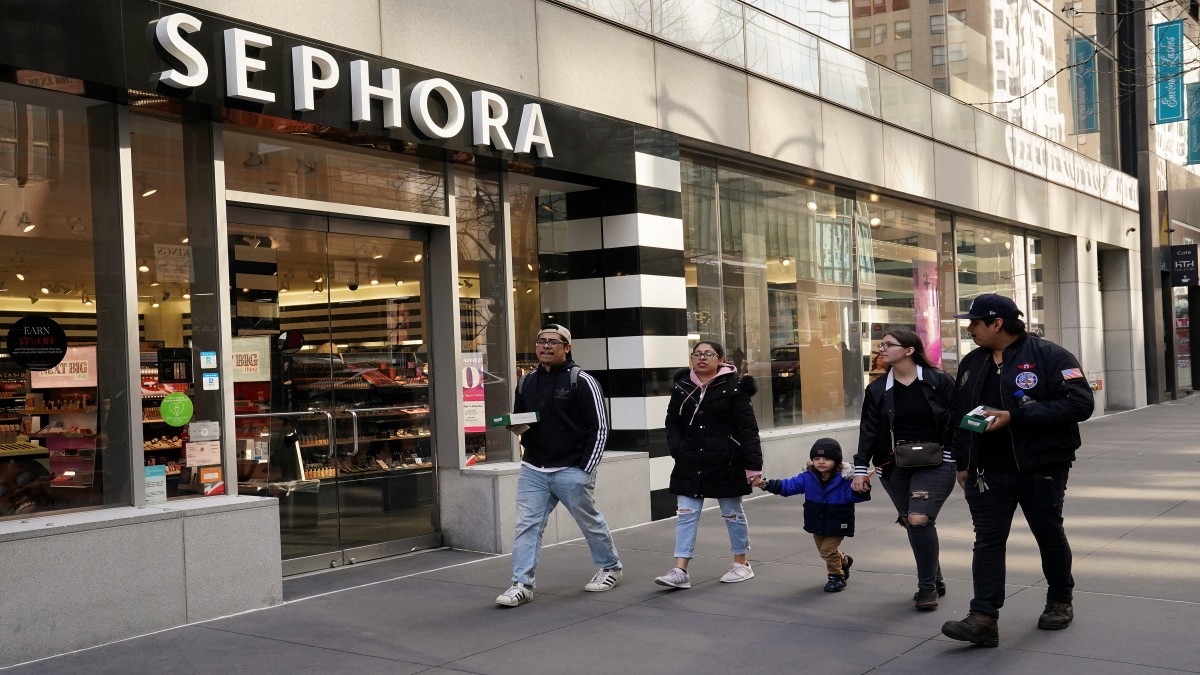There’s a new trend among teens known as “Sephora kids” on the internet.
The catch-all term indicates a newfound love for pricey cosmetics and flashy skin care routines among children and young teenagers.
Dermatologists are alerting people to possible dangers that may be hiding below the surface.
Here’s all we know about the trend.
What is ‘Sephora Kids’ trend?
The “Sephora Kids” craze, which has gained traction on social media, has seen young boys and girls swarming Sephora shelves with great excitement and then sharing videos showing off their incredibly long skin care routines, as per Global News.
The hashtags #sephora or #sephorakids have taken over TikTok and Instagram.
In certain videos, four-year-old kids can be seen going to Sephora with their moms and excitedly choosing various skincare items.
Global News reports that the seven-year-old twins Koti and Haven, who have over 4.8 million followers on TikTok, have become well-known because of their “Get-Ready-With-Me” videos, which include them applying items such as peptide serums, face sprays, and toners.
Videos of retailers and consumers complaining about the little children presence at Sephora and Ulta Beauty and other cosmetic stores have also garnered popularity. They complain about rude young shoppers grabbing products right from other shoppers’ hands and messing up stores and display products.
Denish Shah, an associate professor of marketing at Georgia State University’s Robinson College of Business told BBC News, “Yes, tweens are not only flooding Sephora stores, but they’re also making a lot of purchases of these products online. This category, in general, is seeing a huge increase in sales.”
Impact Shorts
More ShortsWhy are experts concerned?
Lead dermatologist Dr. Renita Ahluwalia of the Canadian Dermatology and Plastic Surgery Centre in Toronto said retinol, exfoliating acids, and fragrance are among the components in some of these treatments that are unhealthy for children’s skin and can damage the skin barrier.
“The problem is when they use a whole bunch of different products that are not designed for young skin, and especially when they’re combining them because they’re doing 10 steps,” Ahluwalia told Global News.
“The risk of irritation and breakdown of the skin barrier and causing dermatitis and acne, which already young people are dealing with as their hormones shift and change. So there are a lot of areas where there can run into trouble.”
In addition to the skin damage, she said that parents may develop a “pricey habit” of purchasing all these products.
“They say they’re interested in skin care because their friends are doing it because it’s on social media,” she said.
Are beauty brands targeting Gen Alpha?
Many skincare and makeup companies have recently introduced their products to serve to younger consumers.
According to BBC News, Yawn, a makeup brand, introduced skincare and makeup lines for clients three years of age and up. Since 2020, Bubble, marketing itself as the “new school skincare,” has been providing products for acne and skin texture. Another brand that caters to tweens and teens but whose products are equally appropriate for eight-year-olds is Gryt.
Drunk Elephant, a self-described “clean beauty” brand owned by Japanese conglomerate Shiseido, also listed which of its products would be advised for children on Instagram in December.
Shah highlights the recent “off the charts” rise in stock prices of California-based cosmetics brand e.l.f. According to the report citing Marketwatch, e.l.f.’s stock price has increased by 203 per cent in the last year.
“The company’s sales have increased exponentially over the past year, and that’s significant because they position themselves as really affordable cosmetics. And if you look at their marketing efforts, they’re all targeted toward that tween demographic,” Shah told the British outlet.
“The market is growing pretty rapidly. There are a lot of new brands launching specifically for tweenage girls,” BBC quoted Jessica DeFino, creator of The Unpublishable, a newsletter behind the scenes of the beauty industry, as saying.
The target audience of the beauty industry is expanding.
The baby and child skincare market is anticipated to reach a global market volume of approximately $380 million by 2028, growing at an annual rate of roughly 7.71 percent, according to Statista data.
By the same year, 160.7 million consumers are anticipated worldwide.
How are they targeting tweens?
Tweens are being marketed by brands in a variety of ways. They develop products aimed towards younger consumers and market them on social media, where an increasing number of “skinfluencers” are active.
Interestingly, this coincides with tweens’ increased usage of social media following their isolation during the pandemic.
And it goes beyond the shops that specialise in cosmetics. Retail stores additionally endorse these goods by stocking cosmetics on their shelves.
“They’re among the biggest consumers of some social media platforms. All that social media time is, in turn, exposing these young users to influencers paid by brands to use and promote beauty and skincare products. Increasingly sophisticated algorithms also feed this exposure, serving users recommendations about beauty tips and influencers after just a few searches on the topic,” Shah was quoted as saying by BBC.
He also brings up the well-known fact that tweens worry a lot about the way they look.
“Tweens are preoccupied with personal appearance. They’re very, very self-conscious in terms of how their growing bodies are going to turn out and about their developing self-identity. There’s a lot of sensitivity around that and that’s existed for decades. And these two factors combined are what’s really driving the sales in these younger demographics,” he says.
With inputs from agencies


)

)
)
)
)
)
)
)
)



